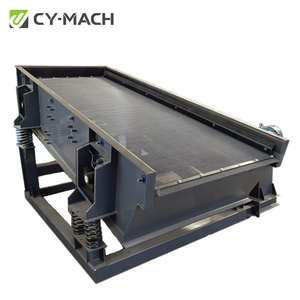
All categories
Featured selections
Trade Assurance
Buyer Central
Help Center
Get the app
Become a supplier

(2739 products available)







































Aggregate screening equipment plays an essential role in the construction industry by efficiently sorting and separating materials to create well-defined aggregates. It encompasses a wide range of machinery, each specifically designed for various tasks in the screening process. Typically, such equipment includes aggregate screens, crushers, and washers. Aggregate screens are key components of this equipment and are commonly employed in aggregate processing plants, quarries, and mining operations. It efficiently separates materials based on their size, allowing for the production of consistent and high-quality aggregates for construction projects.
The screening equipment consists of various types of screens, each catering to specific screening needs. One common type is the inclined vibrating screen, which features a multi-deck configuration, enabling the simultaneous screening of different aggregate sizes. On the other hand, inclined vibrating screens are highly adjustable, allowing operators to optimize the screening process for different materials. Moreover, portable screen plants offer flexibility and mobility, making them suitable for temporary aggregate processing and construction projects in remote locations. These screens are equipped with a transportable chassis, allowing for easy relocation as per the project requirements. The screen plant for sale is designed for heavy-duty applications, capable of handling large volumes of material while withstanding the robust demands of aggregate screening. In contrast, trommel screens are cylindrical in shape and utilize a rotating drum with perforated sections to separate materials by size. In addition, trommel screens are effective in screening soil, compost, and other materials with high moisture content.
Aggregate screens are composed of various essential components, each contributing to the efficient and reliable operation of the screen. The screen box or deck is the primary component where the actual screening of aggregates takes place. It is commonly constructed from high-strength materials and features a series of openings or perforations to allow the passage of sized materials. Additionally, the screen box is often equipped with interchangeable or modular screen media, such as wire mesh, polyurethane, or rubber panels. This allows operators to customize the screen's performance based on the specific application and aggregate being processed. The vibrating mechanism is another critical component of aggregate screens, particularly in vibrating and inclined screens. It typically consists of eccentric shafts, counterweights, and bearings. The vibrating mechanism generates the necessary motion to convey and separate aggregates on the screen deck. For screens with multiple decks, each deck may have its independent vibrating mechanism, enabling the precise control of material flow and screening efficiency. Aggregate screens are often equipped with a variety of features to enhance their functionality and performance. Some screens incorporate adjustable stroke and speed settings, allowing operators to fine-tune the screening process to achieve optimal results. Inclined screens may feature different degrees of slope, which can be adjusted to control the material's travel speed and residence time on the screen deck. This is particularly useful for dewatering applications or when processing materials with varying characteristics. Additionally, some screens are designed with modular deck systems, where individual screen panels can be easily replaced or interchanged. This not only facilitates quick maintenance but also enables operators to adapt the screen configuration for different screening tasks.
The applications of aggregate screens are diverse and encompass various industries where the processing and separation of materials are essential. In the construction industry, aggregate screens play a crucial role in producing different types of aggregates, such as sand, gravel, and crushed stone, which are fundamental building materials for roads, bridges, and structures. In mining and quarrying operations, aggregate screens are used to separate mined materials into different sizes and grades. These screens are integral in the production of aggregates for use in concrete, asphalt, and other construction applications. In the recycling industry, aggregate screens are employed to sort and classify recycled materials, including concrete, asphalt, and aggregates from demolition debris. This screening process helps in the efficient reuse of materials, contributing to sustainable construction practices. Furthermore, aggregate screens are utilized in various agricultural applications, such as in the production of fertilizers and the screening of soil and compost. Their ability to separate and classify materials based on size and texture is invaluable in enhancing agricultural processes. In landscaping and horticulture, aggregate screens are used to produce decorative aggregates and pebbles for gardens and pathways. The screening process ensures that these materials meet the desired size and quality standards. Overall, the versatility and efficiency of aggregate screens make them indispensable in numerous industries, where the precise sorting and separation of materials are essential for quality and performance.